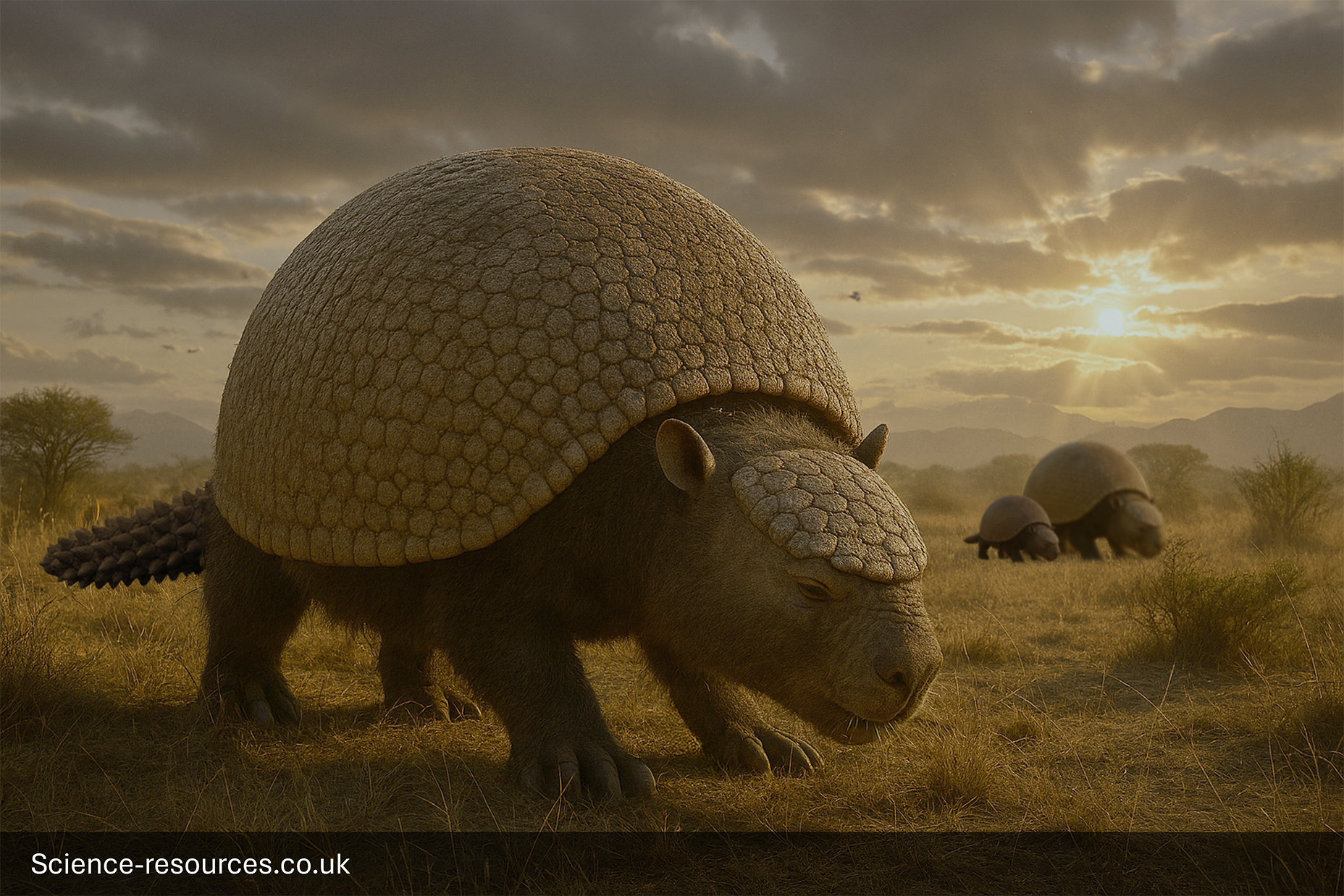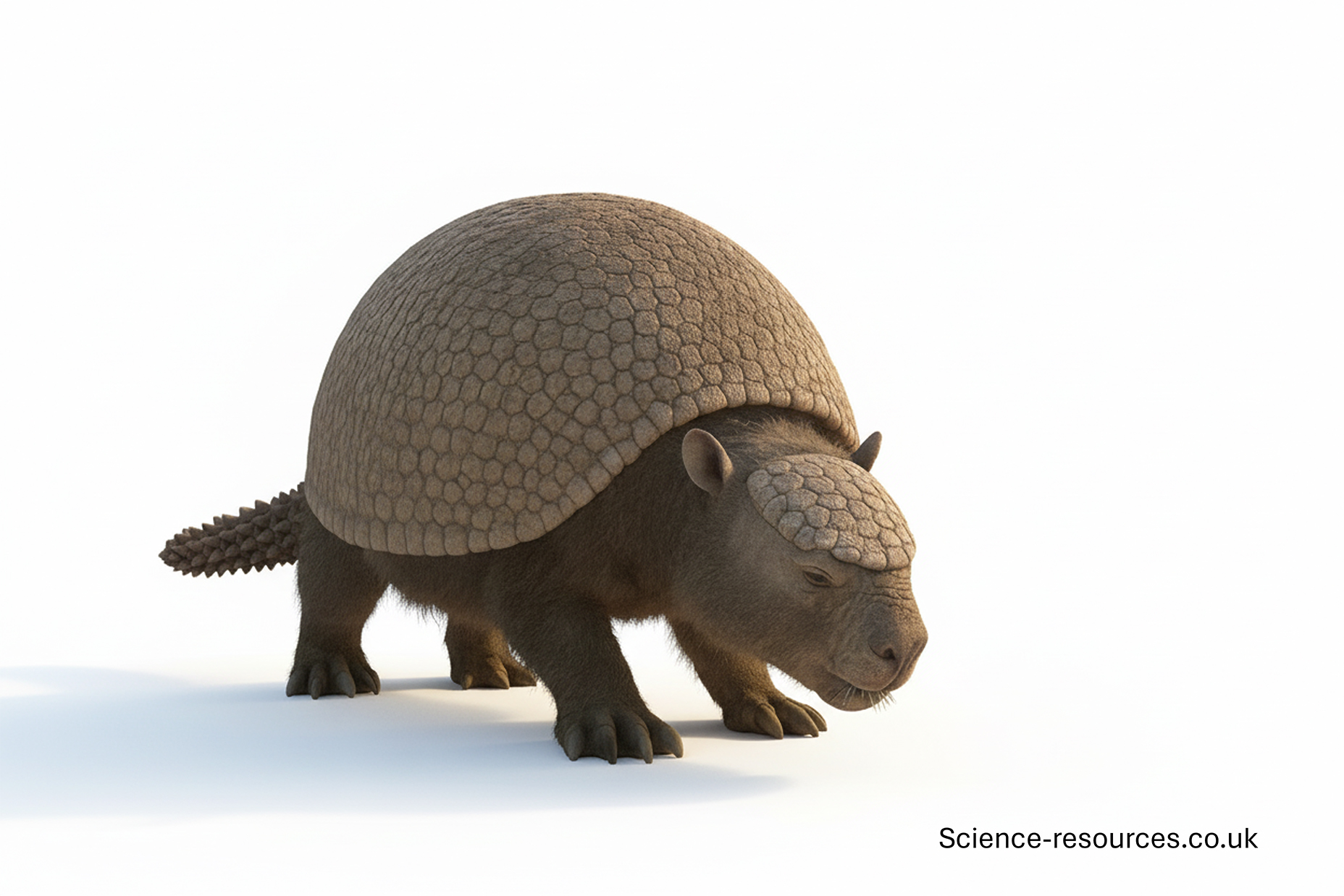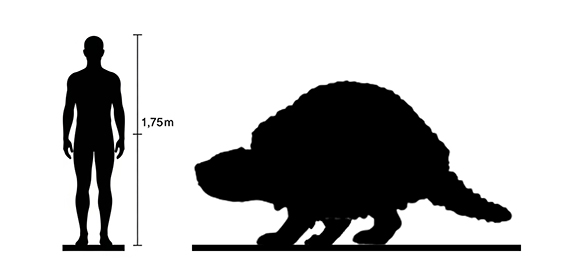Last updated: 4th August 2025
Extinct Animals: Glyptodon
Glyptodon, an extinct, heavily-armored, armadillo native to South America.
Glyptodon (Grooved Teeth)
 Glyptodon
Glyptodon
Generative AI Notification: Some elements of this image have been created or enhanced using AI technology. To find out how we create all our prehistoric animals, click here.
What is Glyptodon?
Glyptodon was a genus of giant, armoured mammals that lived during the Ice Age in South America. It belonged to a group called glyptodonts, famous for their huge, protective shells and strong tails.
How big was Glyptodon?
Glyptodon was about the size of a small car, measuring up to 3 metres (10 feet) in length and weighing around 1,000 kilograms (2,200 pounds). Imagine a car with a turtle shell!
What did Glyptodon eat?
Glyptodon was a herbivore. It used its flat, grinding teeth to munch on tough grasses and other plants found in its habitat.
Glyptodon appearance
Glyptodon had a massive, dome-shaped shell made of bony plates, a short head, and a stout, armoured tail. Its tail was sometimes covered with rings of bone for extra protection against predators.
 Glyptodon appearance
Glyptodon appearance
Where did Glyptodon live?
Fossils have been found mainly in Argentina, Uruguay, Brazil, and other parts of South America. Glyptodon lived in open grasslands and savannas.
Interesting facts
- The shell of a Glyptodon was so tough it could protect it from large predators like saber-toothed cats.
- Early humans may have used empty Glyptodon shells as shelters or protection.
- Glyptodon’s name means “grooved tooth” because of the pattern on its teeth.

Glyptodon Facts
Pronounced: GLIP-toh-don
Name Means: “Grooved Tooth”
Length: Up to 3 metres (10 feet)
Height: About 1.5 metres (5 feet) at the shoulder
Weight: Up to 1,000 kilograms (2,200 pounds)
Diet: Herbivore (plants)
Time: Pleistocene Epoch (about 2 million to 10,000 years ago)
Fossils Found: South America (mainly Argentina, Uruguay, and Brazil)
Which family of animals did Glyptodon belong to?
Glyptodon was a member of the family Glyptodontidae, making it a distant cousin of today’s armadillos.
What other animals lived at the same time as Glyptodon?
It shared its habitat with giant ground sloths, like Megatherium, and saber-toothed cats, such as Smilodon, during the Ice Age.
Glyptodon FAQ
Q1: What was Glyptodon?
A1: Glyptodon was an extinct genus of huge, armoured mammals related to modern armadillos. It lived in South America during the Ice Age.
Q2: What did Glyptodon look like?
A2: Glyptodon looked a bit like a giant armadillo or turtle, with a round, bony shell and a club-like tail for defence.
Q3: How big was Glyptodon?
A3: It was up to 3 metres (10 feet) long and weighed about 1,000 kilograms (2,200 pounds).
Q4: What did Glyptodon eat?
A4: It ate grasses and low-growing plants using its strong, flat teeth.
Q5: Where did Glyptodon live?
A5: Its fossils have been found mostly in Argentina, Uruguay, and Brazil, in open plains and grasslands.
Q6: When did Glyptodon go extinct?
A6: Glyptodon disappeared about 10,000 years ago, likely because of climate change and hunting by early humans.
Q7: What was the purpose of Glyptodon's armour?
A7: Its thick shell and bony tail protected it from predators like sabre-toothed cats and possibly from fights with other Glyptodon.
Q8: How is Glyptodon related to modern animals?
A8: It’s a distant relative of armadillos, sharing ancestors in the order Cingulata.
Q9: Who discovered Glyptodon?
A9: The first Glyptodon fossils were found and described in the 19th century by scientists exploring South America.
Q10: Are there any complete skeletons of Glyptodon?
A10: Yes, many well-preserved skeletons and shells have been found, helping scientists understand how it lived.
You may also be intrested in:
- Extinct Animals: A-Z
- Dinosaurs: A-Z
Tags: How big was Glyptodon, Glyptodon size, where did Glyptodon live, how tall was Glyptodon, what does Glyptodon mean, Glyptodon facts
Previous: Extinct Animals (A-Z)
Up next: Embolotherium
© 2012 science-resources.co.uk. All rights reserved | Design by W3layouts
Extinct Animals: Glyptodon
Glyptodon, an extinct, heavily-armored, armadillo native to South America.
Glyptodon (Grooved Teeth)
 Glyptodon
Glyptodon
Generative AI Notification: Some elements of this image have been created or enhanced using AI technology. To find out how we create all our prehistoric animals, click here.
What is Glyptodon?
Glyptodon was a genus of giant, armoured mammals that lived during the Ice Age in South America. It belonged to a group called glyptodonts, famous for their huge, protective shells and strong tails.
How big was Glyptodon?
Glyptodon was about the size of a small car, measuring up to 3 metres (10 feet) in length and weighing around 1,000 kilograms (2,200 pounds). Imagine a car with a turtle shell!
What did Glyptodon eat?
Glyptodon was a herbivore. It used its flat, grinding teeth to munch on tough grasses and other plants found in its habitat.
Glyptodon appearance
Glyptodon had a massive, dome-shaped shell made of bony plates, a short head, and a stout, armoured tail. Its tail was sometimes covered with rings of bone for extra protection against predators.
 Glyptodon appearance
Glyptodon appearance
Where did Glyptodon live?
Fossils have been found mainly in Argentina, Uruguay, Brazil, and other parts of South America. Glyptodon lived in open grasslands and savannas.
Interesting facts
- The shell of a Glyptodon was so tough it could protect it from large predators like saber-toothed cats.
- Early humans may have used empty Glyptodon shells as shelters or protection.
- Glyptodon’s name means “grooved tooth” because of the pattern on its teeth.

Glyptodon Facts
Pronounced: GLIP-toh-don
Name Means: “Grooved Tooth”
Length: Up to 3 metres (10 feet)
Height: About 1.5 metres (5 feet) at the shoulder
Weight: Up to 1,000 kilograms (2,200 pounds)
Diet: Herbivore (plants)
Time: Pleistocene Epoch (about 2 million to 10,000 years ago)
Fossils Found: South America (mainly Argentina, Uruguay, and Brazil)
Which family of animals did Glyptodon belong to?
Glyptodon was a member of the family Glyptodontidae, making it a distant cousin of today’s armadillos.
What other animals lived at the same time as Glyptodon?
It shared its habitat with giant ground sloths, like Megatherium, and saber-toothed cats, such as Smilodon, during the Ice Age.
Glyptodon FAQ
Q1: What was Glyptodon?
A1: Glyptodon was an extinct genus of huge, armoured mammals related to modern armadillos. It lived in South America during the Ice Age.
Q2: What did Glyptodon look like?
A2: Glyptodon looked a bit like a giant armadillo or turtle, with a round, bony shell and a club-like tail for defence.
Q3: How big was Glyptodon?
A3: It was up to 3 metres (10 feet) long and weighed about 1,000 kilograms (2,200 pounds).
Q4: What did Glyptodon eat?
A4: It ate grasses and low-growing plants using its strong, flat teeth.
Q5: Where did Glyptodon live?
A5: Its fossils have been found mostly in Argentina, Uruguay, and Brazil, in open plains and grasslands.
Q6: When did Glyptodon go extinct?
A6: Glyptodon disappeared about 10,000 years ago, likely because of climate change and hunting by early humans.
Q7: What was the purpose of Glyptodon's armour?
A7: Its thick shell and bony tail protected it from predators like sabre-toothed cats and possibly from fights with other Glyptodon.
Q8: How is Glyptodon related to modern animals?
A8: It’s a distant relative of armadillos, sharing ancestors in the order Cingulata.
Q9: Who discovered Glyptodon?
A9: The first Glyptodon fossils were found and described in the 19th century by scientists exploring South America.
Q10: Are there any complete skeletons of Glyptodon?
A10: Yes, many well-preserved skeletons and shells have been found, helping scientists understand how it lived.
Tags: How big was Glyptodon, Glyptodon size, where did Glyptodon live, how tall was Glyptodon, what does Glyptodon mean, Glyptodon facts
Previous: Extinct Animals (A-Z)
Up next: Embolotherium
© 2012 science-resources.co.uk. All rights reserved | Design by W3layouts